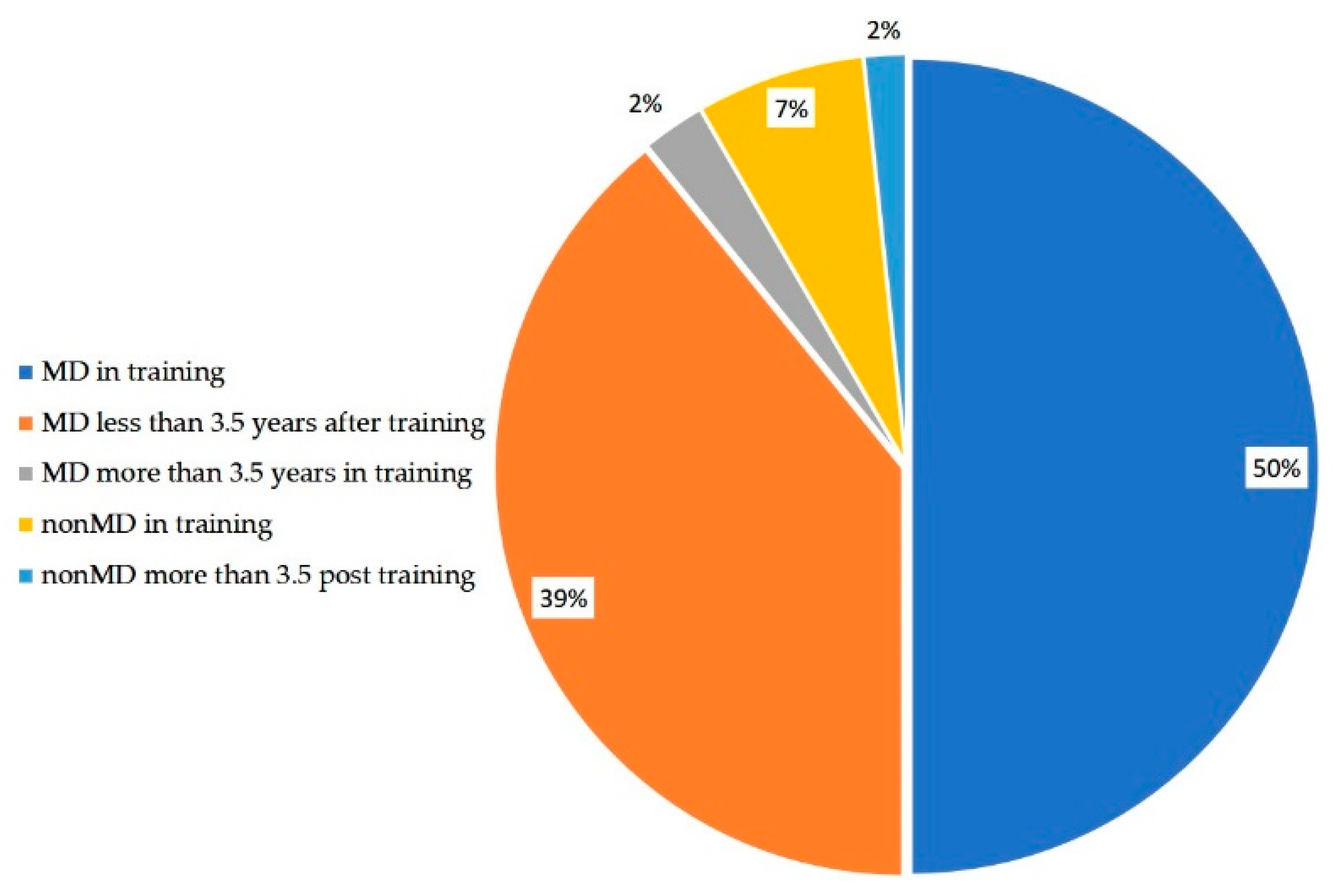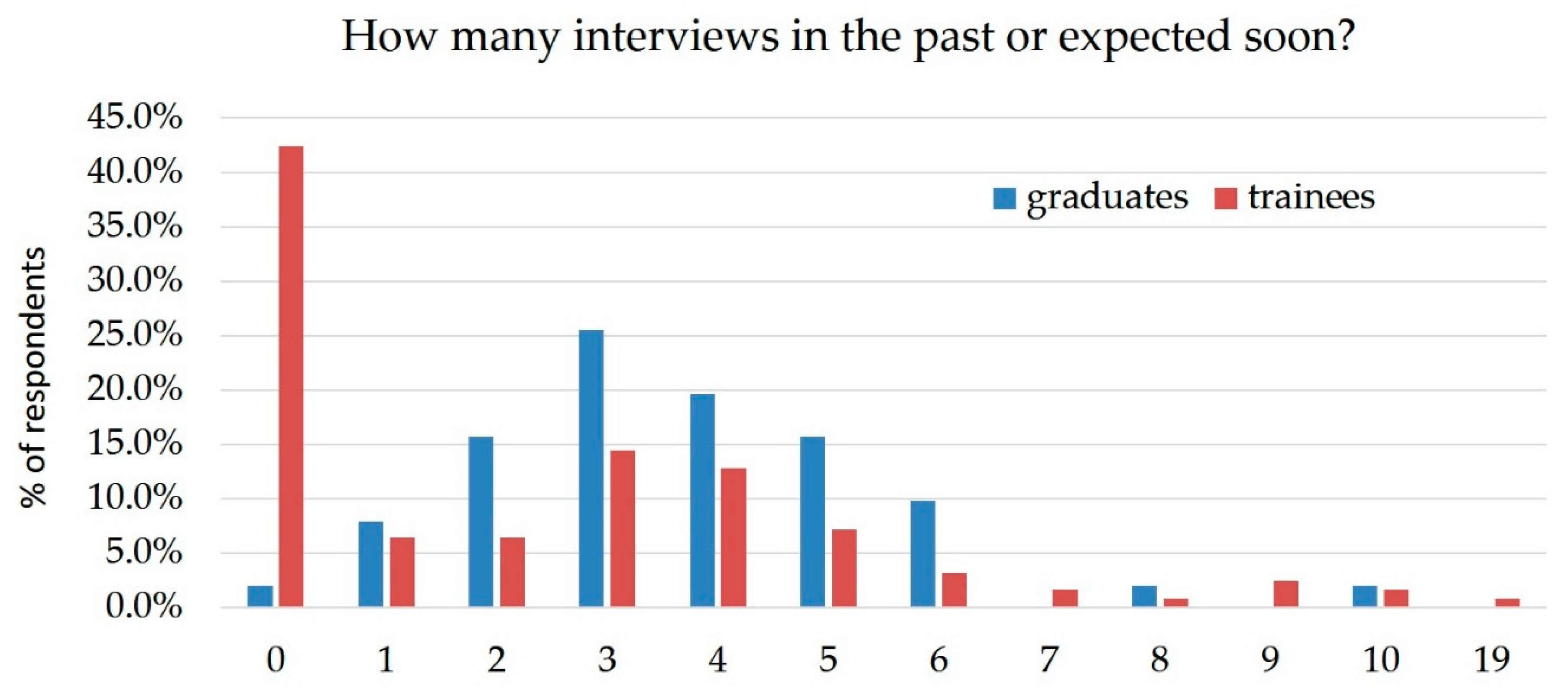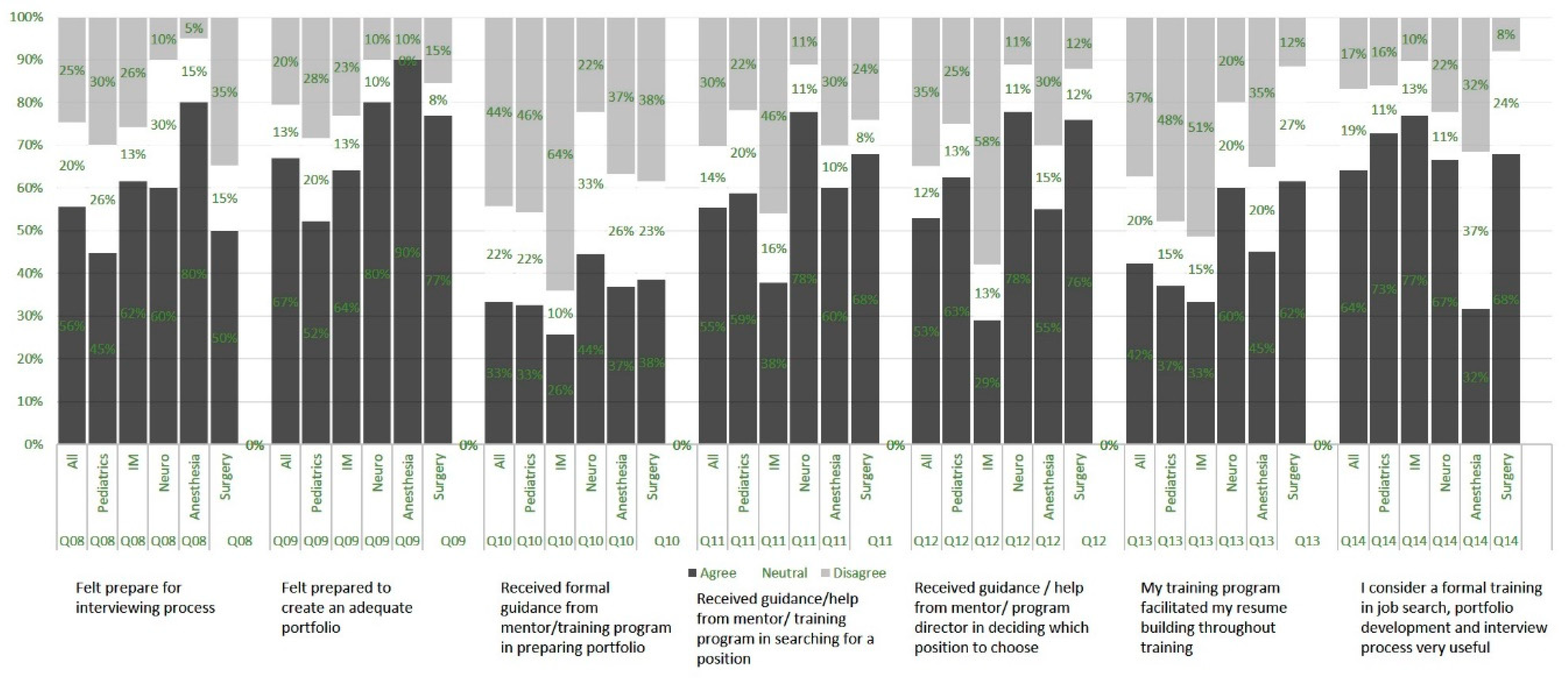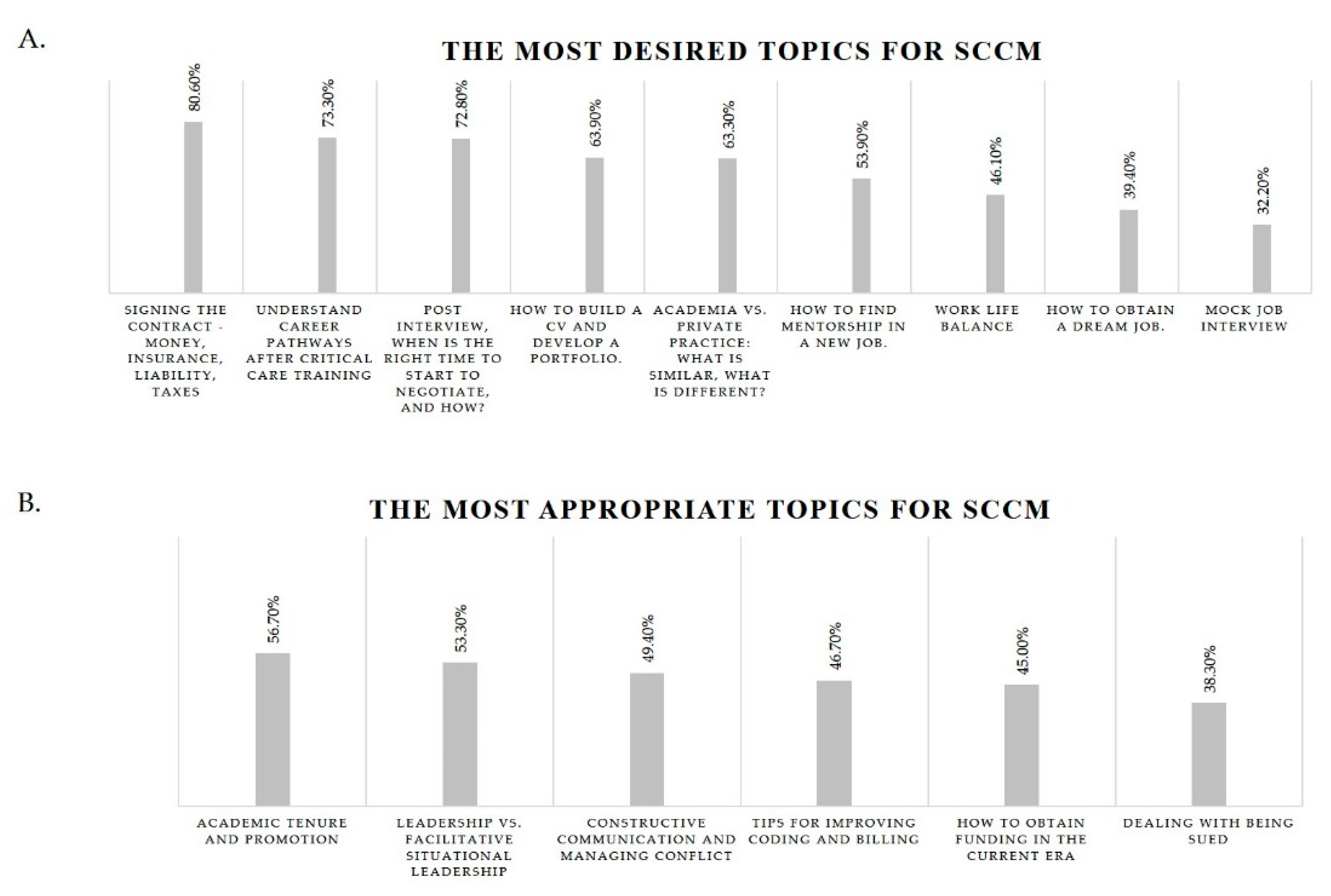Self-Assessment of Preparedness among Critical Care Trainees Transitioning from Fellowship to Practice
Abstract
:1. Introduction
2. Materials and Methods
3. Results
4. Discussion
5. Conclusions
Supplementary Materials
Author Contributions
IRB Statement
Data Availability
Funding
Acknowledgments
Conflicts of Interest
References
- ACGME Competencies for Critical Care Fellowship in Internal Medicine 2016. Available online: https://www.acgme.org/Portals/0/PFAssets/ProgramRequirements/156_pulmonary_critical_care_2017-07-01.pdf (accessed on 20 May 2019).
- Buckley, J.D.; Addrizzo-Harris, D.J.; Clay, A.S.; Curtis, J.R.; Kotloff, R.M.; Lorin, S.M.; Murin, S.; Sessler, C.N.; Rogers, P.L.; Rosen, M.J.; et al. Multisociety Task Force Recommendations of Competencies in Pulmonary and Critical Care Medicine. Am. J. Respir. Crit. Care Med. 2009, 180, 290–295. [Google Scholar] [CrossRef]
- Mullon, J.J.; Burkart, K.M.; Silvestri, G.; Hogarth, D.K.; Almeida, F.; Berkowitz, D.; Eapen, G.A.; Feller-Kopman, D.; Fessler, H.E.; Folch, E.; et al. Interventional Pulmonology Fellowship Accreditation Standards: Executive Summary of the Multisociety Interventional Pulmonology Fellowship Accreditation Committee. Chest 2017, 151, 1114–1121. [Google Scholar] [CrossRef] [PubMed]
- Turner, D.A.; Mink, R.B.; Lee, K.J.; Winkler, M.K.; Ross, S.L.; Hornik, C.P.; Schuette, J.J.; Mason, K.; Storgion, S.A.; Goodman, D.M.; et al. Are pediatric critical care medicine fellowships teaching and evaluating communication and professionalism? Pediatr. Crit. Care Med. 2013, 14, 454–461. [Google Scholar] [CrossRef] [PubMed]
- Yudkowsky, R.; Downing, S.M.; Sandlow, L.J. Developing an institution-based assessment of resident communication and interpersonal skills. Acad. Med. 2006, 81, 1115–1122. [Google Scholar] [CrossRef] [PubMed]
- MacNamara, M.; Wilhelm, A.; Dy, G.; Andiman, S.; Landau, C.; Poshkus, M.; Feller, E. Promoting Quality Care for Recently Resettled Populations: Curriculum Development for Internal Medicine Residents. J. Grad. Med. Educ. 2014, 6, 310–314. [Google Scholar] [CrossRef] [Green Version]
- Arnold, R.M.; Back, A.L.; Barnato, A.E.; Prendergast, T.J.; Emlet, L.L.; Karpov, I.; White, P.H.; Nelson, J.E. The Critical Care Communication project: improving fellows’ communication skills. J. Crit. Care 2015, 30, 250–254. [Google Scholar] [CrossRef]
- Calhoun, A.W.; Rider, E.A.; Meyer, E.C.; Lamiani, G.; Truog, R.D. Assessment of communication skills and self-appraisal in the simulated environment: feasibility of multirater feedback with gap analysis. Simul. Healthc. 2009, 4, 22–29. [Google Scholar] [CrossRef] [PubMed]
- O’Sullivan, P.; Chao, S.; Russell, M.; Levine, S.; Fabiny, A. Development and implementation of an objective structured clinical examination to provide formative feedback on communication and interpersonal skills in geriatric training. J. Am. Geriatr. Soc. 2008, 56, 1730–1735. [Google Scholar] [CrossRef]
- Li, H.; Ding, N.; Zhang, Y.; Liu, Y.; Wen, D. Assessing medical professionalism: A systematic review of instruments and their measurement properties. PLoS ONE 2017, 12, e0177321. [Google Scholar] [CrossRef]
- van Mook, W.N.K.A.; van Luijk, S.J.; O’Sullivan, H.; Wass, V.; Schuwirth, L.W.; van der Vleuten, C.P.M. General considerations regarding assessment of professional behaviour. Eur. J. Intern. Med. 2009, 20, e90–e95. [Google Scholar] [CrossRef]
- AAMC A Guide to Prepare for Your First Job in Academic Medicine 2018. Available online: https://www.aamc.org/download/483868/data/toolkitfirstjob.pdf (accessed on 20 May 2019).
- Snyderman, C.H.; Eibling, D.E.; Johnson, J.T. The Physician as Team Leader: New Job Skills Are Required. Acad. Med. 2011, 86, 1348. [Google Scholar] [CrossRef] [PubMed]
- Lane-Fall, M.B.; Miano, T.A.; Aysola, J.; Augoustides, J.G.T. Diversity in the emerging critical care workforce: Analysis of demographic trends in critical care fellows from 2004 to 2014. Crit. Care Med. 2017, 45, 822–827. [Google Scholar] [CrossRef] [PubMed]
- Borges, N.J.; Navarro, A.M.; Grover, A.C. Women Physicians: Choosing a Career in Academic Medicine. Acad. Med. 2012, 87, 105–114. [Google Scholar] [CrossRef]
- Patel, M.B.; Laudanski, K.; Pandharipande, P.P. An International Career Development Survey of Critical Care Practitioners. Crit. Care Med. 2014, 42, e300–e303. [Google Scholar] [CrossRef] [PubMed]
- Westerman, M.; Teunissen, P.W.; van der Vleuten, C.P.M.; Scherpbier, A.J.J.A.; Siegert, C.E.H.; van der Lee, N.; Scheele, F. Understanding the Transition from Resident to Attending Physician: A Transdisciplinary, Qualitative Study. Acad. Med. 2010, 85, 1914–1919. [Google Scholar] [CrossRef]
- Cogbill, T.H.; Shapiro, S.B. Transition from Training to Surgical Practice. Surg. Clin. North Am. 2016, 96, 25–33. [Google Scholar] [CrossRef] [PubMed]
- Critical Care Medicine|ACP. Available online: https://www.acponline.org/about-acp/about-internal-medicine/subspecialties/additional-training-options/critical-care (accessed on 12 May 2019).
- Weinert, C.R.; Billings, J.; Ryan, R.; Ingbar, D.H. Academic and career development of pulmonary and critical care physician-scientists. Am. J. Respir. Crit. Care Med. 2006, 173, 23–31. [Google Scholar] [CrossRef]
- Pololi, L.H.; Evans, A.T.; Civian, J.T.; Vasiliou, V.; Coplit, L.D.; Gillum, L.H.; Gibbs, B.K.; Brennan, R.T. Mentoring Faculty: A US National Survey of Its Adequacy and Linkage to Culture in Academic Health Centers. J. Contin. Educ. Health Prof. 2015, 35, 176–184. [Google Scholar] [CrossRef] [PubMed]
- Mylona, E.; Brubaker, L.; Williams, V.N.; Novielli, K.D.; Lyness, J.M.; Pollart, S.M.; Dandar, V.; Bunton, S.A. Does formal mentoring for faculty members matter? A survey of clinical faculty members. Med. Educ. 2016, 50, 670–681. [Google Scholar] [CrossRef]
- Garcia, R.L.; Windish, D.M.; Rosenbaum, J.R. Resident career planning needs in internal medicine: A qualitative assessment. J. Grad. Med. Educ. 2010, 2, 518–522. [Google Scholar] [CrossRef]
- Westerman, M.; Teunissen, P.W.; Fokkema, J.P.I.; van der Vleuten, C.P.M.; Scherpbier, A.J.J.A.; Siegert, C.E.H.; Scheele, F. The transition to hospital consultant and the influence of preparedness, social support, and perception: A structural equation modelling approach. Med. Teach. 2013, 35, 320–327. [Google Scholar] [CrossRef]
- Baruch-Feldman, C.; Brondolo, E.; Ben-Dayan, D.; Schwartz, J. Sources of social support and burnout, job satisfaction, and productivity. J. Occup. Health Psychol. 2002, 7, 84–93. [Google Scholar] [CrossRef] [PubMed]
- Shanafelt, T.D.; Bradley, K.A.; Wipf, J.E.; Back, A.L. Burnout and self-reported patient care in an internal medicine residency program. Ann. Intern. Med. 2002, 136, 358–367. [Google Scholar] [CrossRef]
- West, C.P.; Huschka, M.M.; Novotny, P.J.; Sloan, J.A.; Kolars, J.C.; Habermann, T.M.; Shanafelt, T.D. Association of perceived medical errors with resident distress and empathy: A prospective longitudinal study. JAMA 2006, 296, 1071–1078. [Google Scholar] [CrossRef] [PubMed]
- Daniels, R.J. A generation at risk: Young investigators and the future of the biomedical workforce. Proc. Natl. Acad. Sci. USA 2015, 112, 313–318. [Google Scholar] [CrossRef] [PubMed] [Green Version]
- Cyr-Taro, A.E.; Kotwall, C.A.; Menon, R.P.; Hamann, M.S.; Nakayama, D.K. Employment and satisfaction trends among general surgery residents from a community hospital. J. Surg. Educ. 2008, 65, 43–49. [Google Scholar] [CrossRef]
- Lois, M. The shortage of critical care physicians: is there a solution? J. Crit. Care 2014, 29, 1121–1122. [Google Scholar] [CrossRef] [PubMed]
- Halpern, N.A.; Pastores, S.M.; Oropello, J.M.; Kvetan, V. Critical care medicine in the United States: addressing the intensivist shortage and image of the specialty. Crit. Care Med. 2013, 41, 2754–2761. [Google Scholar] [CrossRef]
- MacMillan, T.E.; Rawal, S.; Cram, P.; Liu, J. A journal club for peer mentorship: helping to navigate the transition to independent practice. Perspect. Med. Educ. 2016, 5, 312–315. [Google Scholar] [CrossRef] [PubMed]
- Wolcott, M.D.; Zeeman, J.M.; Cox, W.C.; McLaughlin, J.E. Using the multiple mini interview as an assessment strategy within the first year of a health professions curriculum. BMC Med. Educ. 2018, 18, 92. [Google Scholar] [CrossRef]




| Group Composition | |
|---|---|
| Physician In Training | 112 (62.2%) |
| Recently Graduated Physician | 48 (26.7%) |
| Non-Physician In Training | 13 (7.2%) |
| Recently Graduated Non-Physician | 3 (1.7%) |
| Other | 4 (2.2%) |
| Specialties | |
| Critical Care Medicine - Pediatrics | 66 (37%) |
| Critical Care Medicine - Internal Medicine | 51 (28%) |
| Critical Care Medicine - Surgery | 29 (16%) |
| Critical Care Medicine - Anesthesiology | 21 (12%) |
| Critical Care Medicine - Neurology | 10 (6%) |
| Other | 24 (13%) |
| Preferred Locations (Could Pick Multiple) | |
|---|---|
| Northeast USA | 85 (47%) |
| Southeast USA | 45 (25%) |
| Northcentral USA | 45 (25%) |
| Southcentral USA | 11 (6%) |
| Northwest USA | 40 (22%) |
| Southwest USA | 40 (22%) |
| Anywhere in USA | 22 (12%) |
| Other Locations | 20 (11%) |
| Practice Type | |
| Full Time Academic | 128 (71%) |
| Full Time Private | 24 (13%) |
| Part Time Academic | 16 (9%) |
| Part Time Private | 4 (2%) |
| Other | 8 (5%) |
© 2019 by the authors. Licensee MDPI, Basel, Switzerland. This article is an open access article distributed under the terms and conditions of the Creative Commons Attribution (CC BY) license (http://creativecommons.org/licenses/by/4.0/).
Share and Cite
Watkins, L.; DiMeglio, M.; Laudanski, K. Self-Assessment of Preparedness among Critical Care Trainees Transitioning from Fellowship to Practice. Healthcare 2019, 7, 74. https://doi.org/10.3390/healthcare7020074
Watkins L, DiMeglio M, Laudanski K. Self-Assessment of Preparedness among Critical Care Trainees Transitioning from Fellowship to Practice. Healthcare. 2019; 7(2):74. https://doi.org/10.3390/healthcare7020074
Chicago/Turabian StyleWatkins, Laura, Matthew DiMeglio, and Krzysztof Laudanski. 2019. "Self-Assessment of Preparedness among Critical Care Trainees Transitioning from Fellowship to Practice" Healthcare 7, no. 2: 74. https://doi.org/10.3390/healthcare7020074
APA StyleWatkins, L., DiMeglio, M., & Laudanski, K. (2019). Self-Assessment of Preparedness among Critical Care Trainees Transitioning from Fellowship to Practice. Healthcare, 7(2), 74. https://doi.org/10.3390/healthcare7020074






